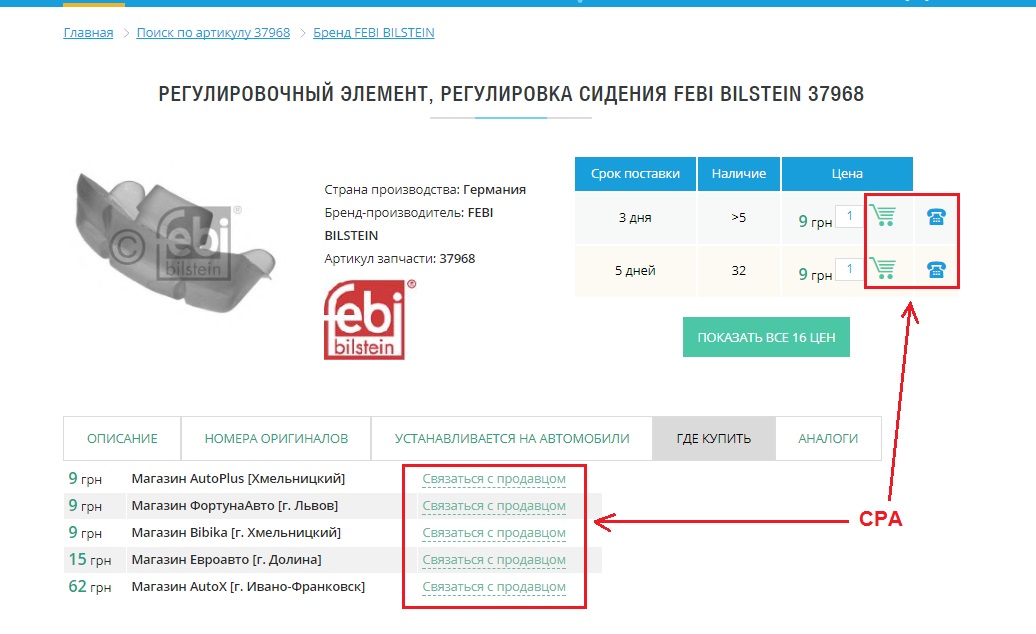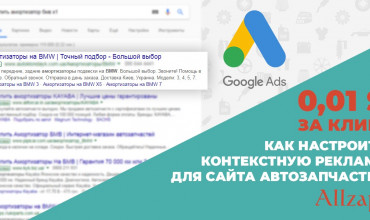
Many people are convinced that for the effective promotion of an online spare parts store, large investments are needed. Often this opinion is supported by facts: a certain amount of money was spent on advertising, and the number of customers did not increase in proportion to the costs. Alas, few people ask the question – was the money spent right?
Before you start promoting an online store, you should figure out how much, to whom and for what you pay, how advertising works and what to expect from it.
The article will be useful for those who have bitter experience and those who plan to start promoting their online store.
Click, impression or order?
There are three main online advertising models: CPM, CPC and CPA. They can be divided into smaller areas, each of which has its own characteristics. But before you get into the intricacies of online marketing, let's try to figure out which advertising model is optimal for an online parts store.
CPM
What is it: CPM (from the English Cost-Per-Thousand — cost per thousand impressions) is an advertising model that came to Internet marketing from the media. It is a banner or teaser placed on a website page in specially designated blocks.
Where it is placed: news media, entertainment and thematic Internet resources, mobile applications, E-mail.
What the advertiser pays for: for 1000 ad impressions.
Efficiency: The effectiveness of CPM depends on the size of the target audience of the site where you advertise and the cost of placing a banner for a certain period of time. The effectiveness of banner advertising is measured by the ratio of the number of clicks to the advertiser's website to the number of impressions (CTR). The average CTR of banner ads is very low – 0.2–0.3%.
What to look for: on the theme of the site and the interests of the target audience. In other words, advertising auto parts on the website "Women's Secrets" will not bring customers.
 < /p>
< /p>CPC
What is it: CPC (Cost-Per-Click – cost per click) – advertising model that implies payment for the target action – clique. The term is closely related to the PPC (Pay-Per-Click) advertising model, which is now often identified with contextual advertising.
Context advertising – type of advertising, the content of which is formed and shown to the Internet user, based on his interests. It is represented by a small informational ad, the content of which corresponds to the user's request and calls for an action – buy, order, go.
Contextual advertising can be divided into three areas:
- PPC. The classic version of contextual advertising in search engines (Google, Bing, Yandex). The advertisement is displayed above the search results, based on the user's request;
- Contextual display advertising (Display advertising). It has flexible settings, due to which the theme of such advertising does not always correspond to the theme of the site on which it is placed. Search engines are guided by the user's last query, his interests, use data about visited sites, location, age, etc.
- Remarketing. It has common characteristics with CMS, but has wider capabilities. With proper configuration, advertisements with a specific product or group of products are shown to a user who previously visited your site, but did not take the necessary action, for example, did not place an order. Such a reminder motivates to return to the purchase, thereby increasing the conversion by 3-5 times.
Where it is placed: depending on the type, it is placed above the search results, as well as on sites that are partners of the advertising network, in mobile applications, in online games.
What the advertiser pays for: for going to their site.
Efficiency: contextual advertising in search results – effective and fast tool to attract customers. Unlike SEO, you don't have to wait several months for results – traffic to the site can be received from the first day. Conversion of classic contextual advertising for the online spare parts store – 3-5%, remarketing – 15-20%.
What to look for: competition in a niche, as the cost of a click and CTR, and, accordingly, the cost of attracting one client, depend on it.

CPA
What is it: CPA (Cost-Per-Action) — readvertising model, which implies payment for the action that the user has performed on the advertising platform, for example, placing an order.
Unlike PPC and CPC, CPA – completely transparent interaction model, as the advertiser pays for the expected and predictable result.
Where it is placed: As such, CPA advertising is not placed anywhere, because its format is different from the classic one. Portals, price aggregators and other sites that offer to perform actions on the pages of their site, without going to the advertiser's site, can work according to the CPA model. However, quite often, large price aggregators working in the auto parts industry prefer the CPC model, as it is more profitable for them. In the process of selecting an analogue spare part, the user clicks on the product on average from 10 to 150 times, while the number of clicks paid by the seller does not guarantee a purchase.
What the advertiser pays for: for the completed action – order, call, etc.
Efficiency: The return for the advertiser is 100%, the share of the total number of orders in the online store ranges from 15-50%.
What to look out for: If the user doesn't complete the intended action, you don't pay for advertising services.

What is the ideal advertising model for an online spare parts store?
There are no bad and good advertising models, but there are badly planned advertising campaigns. In order not to waste your advertising budget, you should choose the right promotion method.
CPM is suitable if you have a large advertising budget and need to make a name for yourself. The model is relevant for promoting the brand, trademark, in order to form a loyal audience. Also, using CPM, you can inform potential customers about promotions, discounts, seasonal sales. For direct sales and regular customer acquisition, it is not recommended to choose this form of payment for advertising services.
CPC is fine if your – bring customers to the site right now. But it should be remembered that the conversion rate largely depends on what conditions you offer the client, and the number of transitions to your – on how well the ad is composed and the advertising company is set up correctly.
CPA is fine if you don't want to risk wasting your budget on clicks and impressions. By choosing CPA, you pay only for the result. However, CPA cannot be considered as the main channel for attracting customers. This option serves rather as an additional source of sales and goes well with SEO optimization and contextual advertising.
But not advertising a single online store of spare parts is alive. There are shareware traffic channels, but in the next article…


